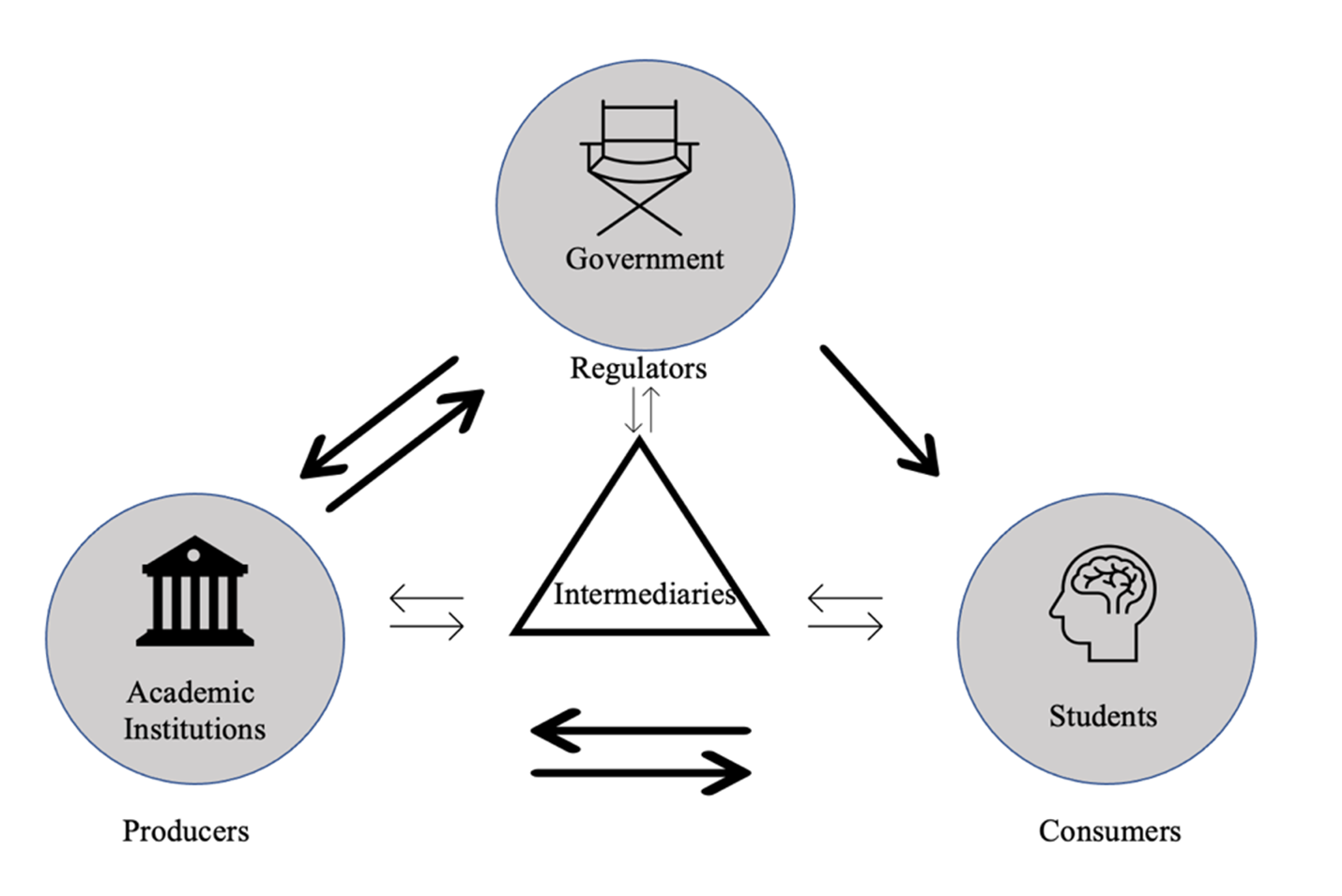College Access Today: The Crux of the Problem: Research & Analysis
 Author’s Note: This edition is excerpted from The Axis of Access: A Quantitative Ethnography of Presidential Discourse on the Construct of College Access in the United States. The full 254-page manuscript was published in April 2022. Key takeaways are shared in this series.
Author’s Note: This edition is excerpted from The Axis of Access: A Quantitative Ethnography of Presidential Discourse on the Construct of College Access in the United States. The full 254-page manuscript was published in April 2022. Key takeaways are shared in this series.
The Problem
Presidential discourse requires a clarified, cross-state understanding of what is meant by the construct of college access and its related narratives. This construct has become commonplace, yet no unified definition or refinement of meaning exists. The study addressed the disconnect in the abstraction of language as leaders present ideas, opinions, and policies in their Discourse related to the rhetorical use of this term.
With over $1.7 trillion in current U.S. student debt, the relationship between the United States, its higher education system, and the operations underpinning those institutions has become increasingly challenging (Hegji et al., 2018). The U.S. public education system exacerbates inequities across socioeconomic strata and racial/ethnicity divides (Chetty et al., 2017). Rather than pointing to the exception of a disproportionately small number of high-achieving, low-SES students attaining college eligibility, readiness, access, and success, with careful use of language and clear definitions of the constructs being referenced progress may be made toward a more equitable playing field.
Currently, hundreds of nonprofit programs in America support students in a one-on-one mentorship paradigm, perpetuating the opportunity gap at scale since some students get help while many more do not. Networks create opportunities—the grit and growth mindset of qualified students cannot overcome the network gap for those students without such mentorship in place. Wealthier students who never know food insecurity, lack of digital access, or time scarcity are at tremendous advantage. The National Association of College Admissions Counselors recommends a ratio of no more than 250 students to 1 counselor. Budgets in public schools would have to triple or quadruple the amount of on-site support to attain that proportion (NACAC, 2021). The national average of 482-to-1, compounded by the fact that the 20% of lowest income school districts allocate little or no budget to the line item of college counseling, contributes to the problems experienced by students from minority groups in particular (Knight, 2003). Reports in Chicago of a 700-to-1 ratio, and 1000-to-1 in Los Angeles make clear that the time for new approaches has arrived (Rowan-Kenyon et al., 2008).
This Quantitative Ethnography study’s purpose was to investigate the communications of U.S. presidents regarding college access. In particular, illuminating impediments experienced by low-SES, disadvantaged, and/or first-generation students to attain college admission within the current rhetorical ecosystem was the study’s primary aim. This examination observed, sought patterns, evaluated, and deconstructed discourse. By Chapter 5, this analysis explored the degree to which, if at all, adjustments in federal communication and educational structures can better ensure college aspiration and persistence toward 4-year degrees for students from marginalized backgrounds.
The overarching research question (RQ) asked: How did U.S. presidents from 2009-2021 communicate a national narrative on the construct of college access? This primary RQ broke into one sub-question (SQ): What observable trends appeared across time in such communications may have impacted social mobility for students from underserved populations?
Significance of the Study
This study contributes to the field by clarifying terminology, identifying narrative arcs, and assessing trends in U.S. presidential communication. Those who could benefit include higher education stakeholders at the U.S. Department of Education, nonprofit leaders in the college access space, and federal leaders in the executive, judicial, and legislative branches of the U.S. government. International leaders whose work intersects the U.S. higher education system may also benefit. Ways they might benefit include (a) adopting working definitions related to college access that align with those of other stakeholders in order to coalesce policies and procedures, (b) revising presumptions about the access equation in U.S. systems for students from low-SES backgrounds, and (c) developing effective incentives using economic and social mechanisms to bridge the information gap in service of increasing equity.
With contributions to the knowledge base among stakeholders, this study may offer incremental awakening to more viable progress toward what is commonly called the American dream of college access. “Is the United States still a land of opportunity?” asks researcher Raj Chetty (Chetty et al., 2014). Related questions asked by researchers across recent decades ponder whether U.S. society fetishizes a 4-year college degree (Shumar, 1997) and whether college should be a public good or a private one (McPherson & Schapiro, 2010). Without infrastructure, professional development, and federal accountability, capitalism can run amok, as seen in the DeVry University and Trump University debacles (Shireman, 2018).
Presidential rhetoric’s role in contributing to higher education’s commodification as a good or service in the context of U.S. free-market capitalism is questioned in this study. In Figure 2, these contributions may impact policy makers, practitioners, and students. Each arrow in Figure 2 represents a flow of communication. Intermediaries include for-profit and nonprofit institutions. Two key takeaways: (a) the student is seen here positioned as a consumer, as stated by former U.S. Secretary of Education Betsy DeVos among others (FSA, 2018), and (b) there is little to no opportunity for contact from those students to the government whose communications and resultant policies directly impact their access to higher education, or lack thereof.
Figure: An Economic Model of College Access Posited as Goods and Services
An original concept created by the researcher

The history of higher education in the U.S. is rife with sociological barriers, from gender and race to economic disadvantage (Aronson, 2008). America’s metanarrative of equitable access calls into question whether the American dream of upward mobility is more hallucinatory than tangible. Since parental education level and zip code are more strongly correlated with college graduation than strong grades and attendance, discourse regarding college access as a construct merits careful parsing (McDonough & Calderone, 2006).
Impact of Financial Need
A dearth of financial aid literacy among potential recipients of Pell Grants and other federal monies obtainable through the FAFSA speaks to what may be seen as the foundational barrier to entry for many first-generation students and other populations. More targeted fiscal support is required to offset the central reason many students under-aspire: money. The three categories of knowledge low-income students need in order to enjoy comparable opportunities as their wealthier peers include information about need-based aid, merit-based institutional aid, and institutional scholarships.
One challenge lies in the fact that direct access to both information and application for these categories of aid above have historically been left to students and their parents. With public school counselors having only an average of 38 minutes per year per student (NACAC, 2021), such support does not typically happen in public high schools. Once students are enrolled in the following year’s coursework, time rarely remains to guide them through the complexities of targeting need-based and merit-based aid, or of identifying viable scholarships.
Impact of Standardized Testing
Much has been written in both academia and the media about the negative impact of standardized testing on access. The College Board and Educational Testing Service (ETS), its test-taking company for the SAT and AP exams, are defended by a team of lawyers in over a million dollars’ worth of legal battles annually, and regularly face criticism by stakeholders in the college admissions industry (Phelps, 2018). In these digital times, privacy has become a major concern for the public. Big data lies at the core of the business models of the most influential companies in the world, including Google, Amazon and Facebook. When it comes to harvesting of student data, The College Board has been criticized in the news and on higher education industry sites for selling names and contact data (PCSP, 2020). When students sign up with The College Board through its PSAT exam, the terms of service allow schools to consent for students, putting their name on a list where colleges and the military can market to them.
SAT and ACT exams are discussed as a genuine threat to equitable college access in many heated presentations and conversations in admissions-related conferences, including NACAC, CoSN, and ALAS. Such concerns tether to the racially uneven outcomes of the admissions process, largely attributed to the negative impact of what are seen as biased entrance requirements (Bloom, 2007; Hachey & McCallen, 2018; Knight et al., 2004).
Impact of Coloniality
Legitimizing higher education as accessible to students from all socioeconomic backgrounds requires an eco-system of diversity, equity, and inclusion. In the face of xenophobia-couched-as-nationalism, and resistance to ethnic inclusiveness among some demographics, such legitimization can prove elusive. The control of knowledge, which is impacted by coloniality (Ayala & Ramirez, 2019), has led to an information gap. This contributes to an opportunity gap, which is then further exacerbated by a social network gap. These and other gaps are disproportionately experienced by low-SES teens as they traverse the U.S. public education system. Economically speaking, the gap between funds needed for college and the need-based or merit-based aid provided by federal or institutional grants and loans looms as a primary part of the problem. This study explored the degree to which, if at all, the rhetoric of access aligns with the lived experiences of students from marginalized backgrounds, with race/ethnicity and SES as primary lenses of interest. This will involve an investigation of modes of making meaning, ways of knowing, epistemological systems, and societal norms of those for whom marginalization has become systemically pervasive. By proposing initiatives in U.S. high schools that permit access to formerly privatized ways of accessing information, the study sought to increase equity and shared privilege, replacing systemic punishment of students lacking financial resources.
The relationship between models of reality and the reality itself has been well explored by semantic scholars, most notably Korzybski (1990). The “map” of language cannot fully denote the real “terrain” of the complex college access construct (1990). In consideration of the notion that “the word is not the thing” (1990, p. xxv), the narrative surrounding higher education was examined with a cautionary eye for the role of abstraction in undermining real-world change.
Any meaning assigned to the college access construct functions at the level of abstraction, and is therefore highly context-dependent. U.S. students may have various reactions to federal communications about college access, but political blame asserting dissatisfaction does little to support actionable improvements. To guard against confusing mental models of reality with the reality itself, this study considered linguistic limitations in capturing the “thing” of college access within the “territory” of the lived experiences of marginalized populations.
References
Aronson, P. (2008). Breaking barriers or locked out? Class‐based perceptions and experiences of postsecondary education. New Directions for Child and Adolescent Development, (119), 41–54. doi:10.1002/cd.208
Ayala, M., & Ramirez, C. (2019). Coloniality and Latinx college students’ experiences. Equity & Excellence in Education, 52(1), 129–144. https://doi.org/https://doi.org/10.1080/10665684.2019.1635542
Bloom, J. (2007). (Mis) reading social class in the journey towards college: Youth development in urban America. Teachers College Record: The Voice of Scholarship in Education, 109(2), 343–368. https://doi.org/10.1177/016146810710900201
Chetty, R., Hendren, N., Kline, P., Saez, E., & Turner, N. (2014). Is the United States still a land of opportunity? Recent trends in intergenerational mobility. American Economic Review, 104(5), 141–147.doi:10.1257/aer.104.5.141
Chetty, R., Friedman, J. N., Saez, E., Turner, N., & Yagan, D. (2017). Mobility report cards: The role of colleges in intergenerational mobility (Working paper). Social Science Research Network. https://doi.org/10.3386/w23618
Federal Student Aid Office. (2018). Top nine pain points for federal student loan borrowers. Federal Student Aid Office, a Division of the U.S. Department of Education. http://www.webcastregister.live/2018fsatc_records/viewv2/1813/
Hachey, V. K., & McCallen, L. S. (2018). Perceptions of campus climate and sense of belonging among non-immigrant, first-generation, and second-generation students. In K. Soria (Ed.), Evaluating campus climate at U.S. research universities (pp. 209–231). Springer.
Hegji, A., Smole, D. P., & Heisler, E. J. (2018). Federal student loan forgiveness and loan repayment programs (R43571). Congressional Research Service. https://crsreports.congress.gov/product/details?prodcode=R43571
Knight, M. G., Norton, N. E., Bentley, C. C., & Dixon, I. R. (2004). The power of Black and Latina/o counterstories: Urban families and college‐going processes. Anthropology & Education Quarterly, 35(1), 99–120. https://doi.org/10.1525/aeq.2004.35.1.99
Knight, M. G. (2003). Through urban youth’s eyes: Negotiating K-16 policies, practices, and their futures. Educational Policy, 17(5), 531–557. https://doi.org/10.1177/0895904803256786
Korzybski, A. (1990). Alfred Korzybski: Collected writings, 1920–1950. Institute of GS.
McDonough, P. M., & Calderone, S. (2006). The meaning of money: Perceptual differences between college counselors and low-income families about college costs and financial aid. American Behavioral Scientist, 49(12), 1703–1718. https://doi.org/10.1177/0002764206289140
McPherson, M. S., & Schapiro, M. O. (2010). Keeping college affordable: Government and educational opportunity. Brookings Institution Press.
National Association of College Admissions Counselors. (2021). Counselor caseloads by state. https://www.nacacnet.org/globalassets/documents/publications/research/2018_soca/soca2019_all.pdf
Parent Coalition for Student Privacy. (2020). Student privacy matters: parents question college board’s use of student data. https://studentprivacymatters.org/tag/college-board-lawsuit/
Phelps. (2018). Does college board deserve public subsidies? Nonpartisan Education Review 14(7), 1–45. http://nonpartisaneducation.org/Review/Articles/v14n7.pdf
Rowan-Kenyon, H. T., Bell, A. D., & Perna, L. W. (2008). Contextual influences on parental involvement in college going: Variations by socioeconomic class. The Journal of Higher Education, 79(5), 564–586. https://doi.org/10.1080/00221546.2008.11772117
Shireman, R. (2018). Selling the American dream: What the Trump University scam teaches us about predatory colleges. Social Research: An International Quarterly, 85(4), 767–794. https://www.muse.jhu.edu/article/716114
Shumar, W. (1997). College for sale: A critique of the commodification of higher education. Psychology Press.
*******
Join my College Access Group. Opt in here https://lp.constantcontactpages.com/su/4Jn1HTJ/collegeaccess
